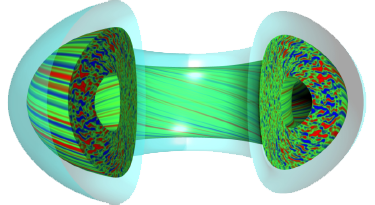Speaker
Description
During a typical fusion experiment, the plasma can have several different confinement modes. At the TCV tokamak, it is typically classified as being in either Low(L), Dithering(D) or High(H) confinement mode. All plasma discharges, during the initial ramp-up phase, begin in L mode. By applying sufficient heating power, the plasma spontaneously transitions into H mode (typically at TCV this process lasts approximately 1 ms). This new mode is termed High confinement because, once it is reached, one can observe significantly reduced transport of particles and energy from the plasma to the surrounding vessel walls. In some cases the transition from L to H mode does not happen directly, but rather the plasma oscillates rapidly between the two confinement regimes. In this case, the plasma is considered to be in a Dithering mode.
Many studies have been done on the physical factors behind the transition between L and H mode, but the phenomenon is still not completely understood. Furthermore, there is no simple set of rules that can be used to determine the plasma mode given the values of signal time series data during a fusion experiment. Nevertheless, most of the time, there are highly salient patterns in these measured signals that can be used by domain experts to determine the plasma mode with high confidence.
The process of manually labelling experimental data can be quite cumbersome in many cases, particularly when one wishes to conduct large studies and analyse many shots. For that reason, work has been put into developing tools capable of automating the task of detecting different plasma confinement modes. In particular, in the past few years, research has been done on using machine learning and, more recently, deep learning for this task. Those algorithms are particularly suitable for dealing with challenges of extracting patterns from high-dimensional time series data collected during fusion experiments.
Previous work with deep learning methods, particularly convolutional long short-term memory networks (conv-LSTMs), indicates that they are a suitable approach for this task. Nevertheless, those models are sensitive to noise in the temporal alignment of labels, and are limited to making individual decisions taking into account only the input data at a given timestep and the past data. The paper presents an architecture for a sequence-to-sequence neural network model with attention which solves both of those issues. Using a carefully calibrated dataset, the paper compares the performance of a conv-LSTM with that of its proposed sequence-to-sequence model, and shows two results: one, that the conv-LSTM approach can be improved upon with new data; two, that the sequence-to-sequence model can improve the results even further, achieving excellent scores on both train and test data.
| Country or International Organisation | Germany |
|---|---|
| Affiliation | AppliedAI Initiative -- UnternehmerTUM GmbH |

